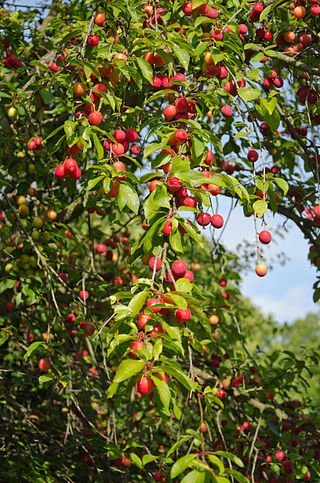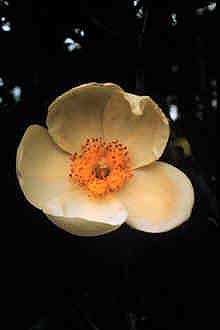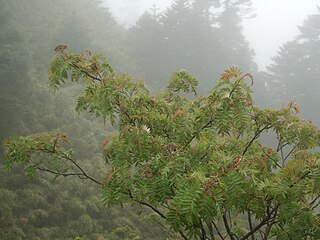
Prunus is a genus of trees and shrubs, which includes the fruits plums, cherries, peaches, nectarines, apricots, and almonds.

The cherry blossom, also known as a Japanese cherry or Sakura, is the flower of trees in the genus Prunus or the Prunus subgenus Cerasus. Wild species of the cherry tree are widely distributed, mainly in the Northern Hemisphere. They are common in East Asia, especially in Japan. They generally refer to ornamental cherry trees, not cherry trees grown for their fruit. The cherry blossom is considered the national flower of Japan.

Prunus subg. Padus is a subgenus of Prunus, characterised by having racemose inflorescences. Padus was originally a distinct genus, but genetic and morphological studies have shown that Padus is polyphyletic. It has been proposed that all the racemose taxa within Prunus are incorporated into a broad-sense Prunus subg. Padus.

Prunus cerasifera is a species of plum known by the common names cherry plum and myrobalan plum. It is native to Southeast Europe and Western Asia, and is naturalised in the British Isles and scattered locations in North America. Also naturalized in parts of SE Australia where it is considered to be a mildly invasive weed of bushland near urban centers.

Prunus serrulata or Japanese cherry is a species of cherry tree that grows naturally in Japan, China, and Korea, and it also refers to a cultivar produced from Prunus speciosa, a cherry tree endemic in Japan. Historically, the Japanese have developed many cultivars by selective breeding of cherry trees, which are produced by the complicated crossing of several wild species, and they are used for ornamental purposes all over the world. Of these, the cultivars produced by complex interspecific hybrids based on the Oshima cherry are also known as the Cerasus Sato-zakura Group.

Gordonia is a genus of flowering plants in the family Theaceae, related to Franklinia, Camellia and Stewartia. Of the roughly 40 species, all but two are native to southeast Asia in southern China, Taiwan and Indochina. The remaining species, G. lasianthus (Loblolly-bay), is native to southeast North America, from Virginia south to Florida and west to Louisiana; G. fruticosa is native to the tropical rainforests of Central and South America, from Costa Rica to Brazil.

Prunus × yedoensis is a hybrid cherry tree between Prunus speciosa as father plant and Prunus pendula f. ascendens as mother. It is a hybrid born in Japan and one of its cultivars, Prunus × yedoensis 'Somei-yoshino' or Yoshino cherry, is one of the most popular and widely planted cherry cultivars in temperate regions around the world today. 'Somei-yoshino' is a clone from a single tree, and has been propagated by grafting all over the world. 'Somei-yoshino' inherits Edo higan's quality of blooming before the leaves unfold and it growing into a large-sized tree. It also inherits the characteristics of the Oshima cherry, which grows rapidly and has white flowers. These characteristics are favored and have become one of the most popular cultivars of cherry trees.

Prunus incisa, the Fuji cherry, is a species of flowering plant in the family Rosaceae, which gets its scientific name from the deep incisions on the leaves. It is an endemic species in Japan and grows wild in Kantō, Chūbu and Kinki regions. It is called the Fuji cherry because it grows in particular abundance around Mount Fuji and Hakone. A dainty slow-growing, early white-flowering cherry tree, this century-old cultigen from Hondo, Japan is highly regarded as an ornamental but the wood has no industrial value. It is hardy to -20 °C, and crossed with Prunus speciosa, has yielded the cultivar Prunus 'Umineko'. It is in the ornamental section Pseudocerasus of the cherry subgenus Cerasus of the genus Prunus. Ma et al. classified it in a group with Prunus nipponica.

Prunus maackii, commonly called the Manchurian cherry or Amur chokecherry, is a species of cherry native to Korea and both banks of the Amur River, in Manchuria in northeastern China, and Amur Oblast and Primorye in southeastern Russia. It used to be considered a species of Prunus subg. Padus, but both morphological and molecular studies indicate it belongs to Prunus subg. Cerasus.

Prunus speciosa, the Oshima cherry, Japanese オオシマザクラ, is native to Izu Ōshima island and the Izu Peninsula on Honshū near Tokyo, Japan.

Prunus avium, commonly called wild cherry, sweet cherry, gean, or bird cherry is a species of cherry, a flowering plant in the rose family, Rosaceae. It is native to Europe, Anatolia, Maghreb, and Western Asia, from the British Isles south to Morocco and Tunisia, north to the Trondheimsfjord region in Norway and east to the Caucasus and northern Iran, with a small isolated population in the western Himalaya. The species is widely cultivated in other regions and has become naturalized in North America and Australia.
Gaultheria nummularioides is a species of plant in the family Ericaceae. It is distributed across India, Myanmar, Nepal, Bhutan, Indonesia, and Southwest China. The plant grows in areas between 1,700 and 3,000 m above sea level, and grows better on rocky mountainsides and weed tree forests. This species has been cultivated as an ornamental in Britain, the United States, and elsewhere for some decades.

Prunus subg. Prunus is a subgenus of Prunus. This subgenus includes plums, apricots and bush cherries. Some species conventionally included in Prunus subg. Amygdalus are clustered with plum/apricot species according to molecular phylogenetic studies. Shi et al. (2013) has incorporated subg. Amygdalus into subg. Prunus, thereby including almonds and peaches in this subgenus. The species in this subgenus have solitary flowers or 2–3 in a fascicle.

Prunus × nudiflora is a Korean native cherry tree originating from Jeju Island. It is a distinct species from Japanese native Yoshino cherry. King cherry is a rare plant and listed as an endangered species. As of April 2017, 194 king cherry trees were growing around Mt. Halla in Jeju Island. According to Gen-ichi Koidzumi, king cherry is erroneously believed to be discovered by a French missionary Émile Joseph Taquet although what he discovered was a different species.
Boltonia lautureana is an East Asian species of plants in the family Asteraceae. It is native to China, Japan, Korea, and Asiatic Russia.

Sorbus randaiensis is a species of deciduous tree in the family Rosaceae. It is endemic to the mountain areas of central Taiwan, with altitude 1,800m to 3,200m, mostly spotted in the forest of Xueshan, Hehuan Mountain, Mount Xiluan, and Nenggao Mountain. It is a tree 3–8 m tall with white flowers and reddish fruit.
Prunus humilis is a species of bush cherry native to northern China. It is cultivated for its edible fruit. Chloroplast DNA sequencing has shown that its closest relative is Prunus dictyoneura, at least as far as chloroplasts are concerned.

Prunus subg. Cerasus is a subgenus of Prunus. Species of the subgenus have a single winter bud per axil. The flowers are usually in small corymbs or umbels of several together, but some species have short racemes. The fruit is a drupe and has no obvious groove along the side. The subgenus is native to the temperate regions of the Northern Hemisphere, with two species in North America, four in Europe, two in North Africa, and the remainder in Asia.
Prunus dictyoneura is a species of bush cherry found in Gansu, Hebei, Henan, Jiangsu, Ningxia, Shaanxi and Shanxi provinces of China. A shrub 0.3 to 1.0 m tall, it prefers to grow in thickets in grasslands on hillsides from 400 to 1600 m above sea level. Chloroplast DNA sequencing has shown that its closest relative is Prunus humilis, at least as far as chloroplasts are concerned.
Prunus pogonostyla, the hairy-style cherry, is a species of flowering plant in the family Rosaceae, native to Manchuria, southeastern China, and Taiwan. A shrub or tree reaching 1.5 m (5 ft), with pink flowers, it is typically found growing on forested hillsides from 300 to 800 m.
















